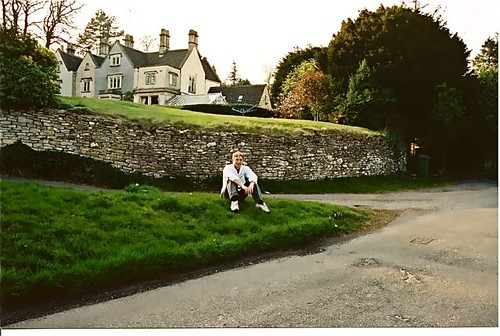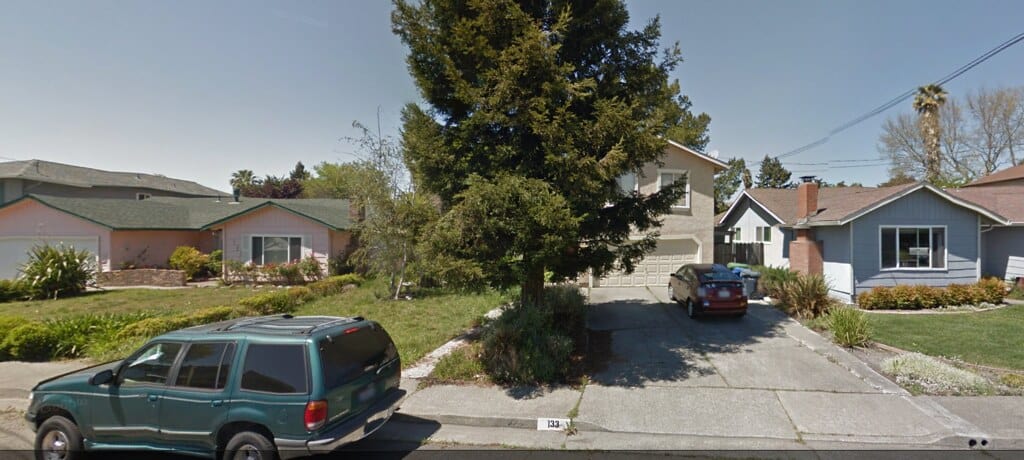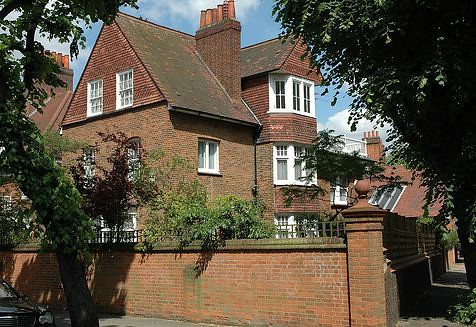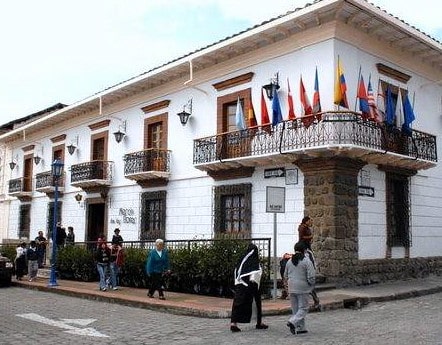Merri’s and my secret investing weapon has been a personal anchor of value.
See how that anchor helped me buy this manor house in the Cotswold.

This huge, old manor house, built over a century, beginning in the 1700s… had wonderful views and our next-door neighbor was Princess Anne at Gatcomb Park. Buying it was a pretty big step for a middle-class American from Rockwood Oregon, but I was able to do so due to my anchor of value.
Last year as part of our 50th year anniversary I was interviewed on Jackie Lange’s investment webinar and jackie asked me this question:
There are a lot of real estate investors who have been successful in buying, selling, and holding real estate in their own backyards. A few have been successfully investing in 2-3 markets in the USA.
But it is rare to find a successful real estate investor who has been investing in real estate all over the world.
And even more rare to find a real estate investor who has been successfully investing all over the world for FIFTY (50) years!
You are that guy! What’s the secret?
My secret to freedom has been to use an anchor of value that I developed to invest in American residential real estate. Though I created this anchor in the 1960s it has helped me invest in real estate, stocks, bonds, and business around the world to this day.
The philosophy behind this strategy and tactics can be used to create your own anchor for investing in shares, bonds, currencies or commodities as well as real estate.
Let’s look at value first. The anchor helps me understand that I am investing for profit, not to be right.
Based on the “profit rather than pride” principle there are two (and only two) reasons why we invest in real estate. To rent for income or to resell the property for more than we had invested.
Based on this reasoning, there are three ways to spot value in residential property.
#1: The first way to spot value is based on how much NET income can the property generate after taxes, insurance, maintenance, and management costs.
#2: The second method is based on relative comparables. Calculate how much similar properties in the area are selling for. Also, find out how much similar properties in other areas are selling for.
#3: The third method is to calculate how much a property would cost to replace with new construction.
What is the anchor?
We can build an understanding of residential value by understanding the monthly mortgage payment or rent a buyer or renter can pay. In the USA, for example, the typical bank limit on monthly mortgage payments is about 28 percent of your gross monthly income. Banks generally will let a borrower devote up to 28 percent of their household income in a mortgage payment and expenses (including taxes, insurance and HOA dues).
If there are many families in an area who earn an average of $4,000 a month, then this will be a good market for rentals at $1,000 a month.
This simple formula provides a basis from which all dependable value can be measured. This is the science of valuation.
Using this approach, years ago, Merri and I have been able to spot dozens of contrasts, distortions & trends in real estate value, everywhere.
An added factor to add into the mix is appeal. You could call appeal the art of the valuation.
Sometimes an investment can be a really good value, but a hard sell. The best investments are underpinned by appealing good value products and services.
Investing in what you know (and enjoy) helps you understand appeal and makes it easier to mesh the art and the science of valuation.
For example, Merri’s and my background have a lot in common. Merri’s formative years were in Georgia and mine in Oregon. There were many differences between these states. Yet as baby boomers we have much in common. We saw the same shows on TV, Howdy Doody, the Cisco Kid, Ed Sullivan, Gunsmoke. Roy Rogers, etc. We read the same books in school such as the Bridge over San Luis Rey, the Red Badge of Courage. We saw the same movies, heard the same radio , listened to the same Golden Oldies, read the same news, the same magazines, so it is not surprising that our tastes are pretty much the same.
The fact we are NOT special gives us the ability to understand appeal. There are 60 million baby boomers who have that same background. This gives us confidence that if we like a house, others will like it as well. This gives us good judgment (from an investing point of view) when it comes to appeal.
Our strategy is to buy houses that appeal to us which have a reasonable potential to return a decent income (and likely appreciate) based on rent in the $1000 a month range.
For example, we recently looked at a nice house just offered and with access to a wonderful lake, 2 bedroom, 2 bathroom, in very good shape with an asking price of $169,000. The house fit the $1,000 profile and because it had a very nice guest cottage as well, meant we could likely charge $1,200 a month rent. Merri and I looked the place over and felt just fine offering $140,000, knowing we could go up to $145,000.
How did we come to such a price?
The math worked like this. The house will rent for $1,200 a month. The rental market is strong and at this price it will rent quickly. That creates an income of $14,400 a year. Our target ratio of price to rent is 10%. We want a 10% cash flow, so $14,400 a year rent justifies a $14,400 price.
First, the area where we are buying is in a bit of a bubble. Prices have started to rise beyond a reasonable expectation of return. We did not think the house would rent for $1,300 or $1,400 a month so we were not willing to rise to the $169,000 price.
We did not get that house. In fact this was the fifth house in a row on which we were outbid. Because faith is vital to successful investing, we need to stick to our strategy, and our strategy is based around that 10% cash flow. That percentage is sufficient to give us a reasonable return on our investment.
Just because everyone else is paying too much for houses, does not mean we should make this error as well.
Anchors of value help us remain logical so we don’t invest in trends that are turning into bubbles. Anchors of value help us avoid giving back profits because we stayed in a trend for too long.
For example, my real estate anchor of value first created in Portland, Oregon in the 1960s helped me successfully understand good real estate trends in Hong Kong, Fiji and London, then the Isle of Man, Naples Florida, Dominican Republic and Ecuador and eventually led Merri and me to invest in Smalltown USA in Ashe county North Carolina and Mount Dora, Florida.
Real estate has always been in our blood. I do not know why but by the age 21, I had already built a $2,000 windfall into seven duplexes and a house on 14th Ave (mortgaged then to the hilt) in the small town of Gresham, Oregon. I could have continued to buy, sell and rent real estate in Oregon but the wanderlust bug bit me and when I was offered a job to sell mutual funds in Hong Kong, I began to travel throughout Asia.
Owning those duplexes and that house left me with an anchor of value. I understood rents (at that time the 1960s) from $125 in Smalltown USA to $250 a month in cities.
When I arrived in Hong Kong in 1968 real estate rentals were about the same as in downtown Portland.
Fear had created good value in Hong Kong. In 1968 there were communist riots and bombs being set off in the streets. The first day I arrived a motorcycle policeman had his leg blown off by a terrorist bomb. The Chinese army was massed on the border and there were continual talks about an invasion. Hong Kong businessmen were fleeing. Real estate was literally being given away.
Life went on. We all figured out the fastest route to the British and American war ships in the harbor for a quick exit in case the Chinese decided to invade. We watched out for boxes in the street that could be bombs. Then we just got busy with life, working and earning so we could pay our rent.
I rented a huge apartment on Shouson Hill Road overlooking the ocean and the village of Aberdeen. The owner wanted to sell this block of apartments but I had no money or experience then. He was so desperate that he made a deal. Instead of paying him $250 a month rent I invested $250 into mutual funds for him.
Then in 1970 the company I worked for sent me to London to spend a year at its headquarters developing a European sales training program. I rented a nice house near Golders Green tube station on Finchley Road. The rent was the equivalent of $250 a month.
In 1971 I was moved to work in San Francisco and I purchased a home in Petaluma, California.

I bought this house in Petaluma California for $33,000 and assumed a 5% GI mortgage. Payments were about $175 a month.
In 1972 I returned and worked in Hong Kong for another four years.
The early 1970s was a time of serious inflation. During that time I watched the prices and rents of real estate at the duplexes in Gresham, the house in Petaluma, and especially in Hong Kong rise… a lot!
In 1976, when I moved from Hong Kong back to London and noticed that London real estate was priced about the same as it had been in 1970. This puzzled me. Why had London property prices remained flat despite inflation?
On investigation, I learned that there had been a huge real estate crash in 1970 continued to distort and dampen real estate prices six years later despite the rampant global inflation. The British pound had also collapsed dropping 35% versus the U.S. dollar from 2.4 dollars per pound to a new all time low of 1.52 dollars per pound and at one point hit a low of one dollar per pound. To my way of thinking, London houses, which I thought were already very cheap by world standards, just became 35% cheaper.

The house in Bedford Park.
I could not resist and began property shopping and eventually bought a five bedroom house in Bedford Park in West London. I made a 10,000 pound down payment and took a 25,000 pound loan to meet the 35,000 pound asking price.
First, I was right. London property had been under priced. I was able to sell the house four years later for 115,000 Pounds. I made a profit of 80,000 pounds. But the currency change helped enormously too. The pound had risen to over 2.2 dollars per pound. My 80,000 pound profit was now worth $215,000.
I was willing to make this purchase because I could rely on a mental anchor of value… a residential property that a working person could rent in the $250 a month range. I was investing in what I knew and was comfortable with.
Manx real estate came next. In the 1980s I had an offshore corporate formation business and noticed that Isle of Man overseas companies were as good as Jersey and Guernsey structures, but cost less than half. This led me to believe that the Isle of Man would increase in popularity as a financial center. While visiting, Merri and I discovered that a long depression had forced over 2,000 properties onto the Island real estate market (population was only 60,000). We began taking real estate buying tours to the Isle of Man because rents and house prices were so low. Some delegates purchased remodeled beach front condos for $12,000.
Then while conducting a seminar in Florida, we saw that real estate in Naples, Florida was much less expensive than on the East Coast of Florida. Rents in Miami and Ft. Lauderdale seemed really high to us, but Naples prices were much lower. Merri had been living in Naples for some time and found a wonderful old large house just off the beach. We bought it for a song (compared to the price we sold it for!)
Naples prices skyrocketed while we were living there and in 1995 we visited Ecuador. Merri and I saw Ecuadorian beach front lots that would cost two million dollars in Naples that were selling for $5,000. We saw we could buy a house on Ecuador’s beach for a price that we understood and were comfortable with.

Cotacachi hotel El Meson de las Flores
A hotel we purchased in Ecuador.
By 2009 Ecuador prices has skyrocketed and Florida real estate faltered. We began selling out our Ecuador real estate and buying again in Florida.
In Florida we saw great rental value. We also wanted to live closer to our children and grandchildren. We knew that studies had shown that 80% of adults 45 and older believe it is important to live near their children and grandchildren. Those 60 million people, just like us, were thinking differently about where they would buy and/or rent a home.
We selected Mt. Dora as a small town to buy rental real estate for numerous reasons, but the first feature was its proximity to our daughter and grandson.
I can look back through this 50 year travel and real estate adventure and see that my decisions and investments have all been linked to that original anchor of value.
We live in a turbulent world and can expect rapid change, hidden agendas, huge shifts in communication. When we are caught in the currents of such rapid shifts, our anchors of value can help us remain steady and secure.